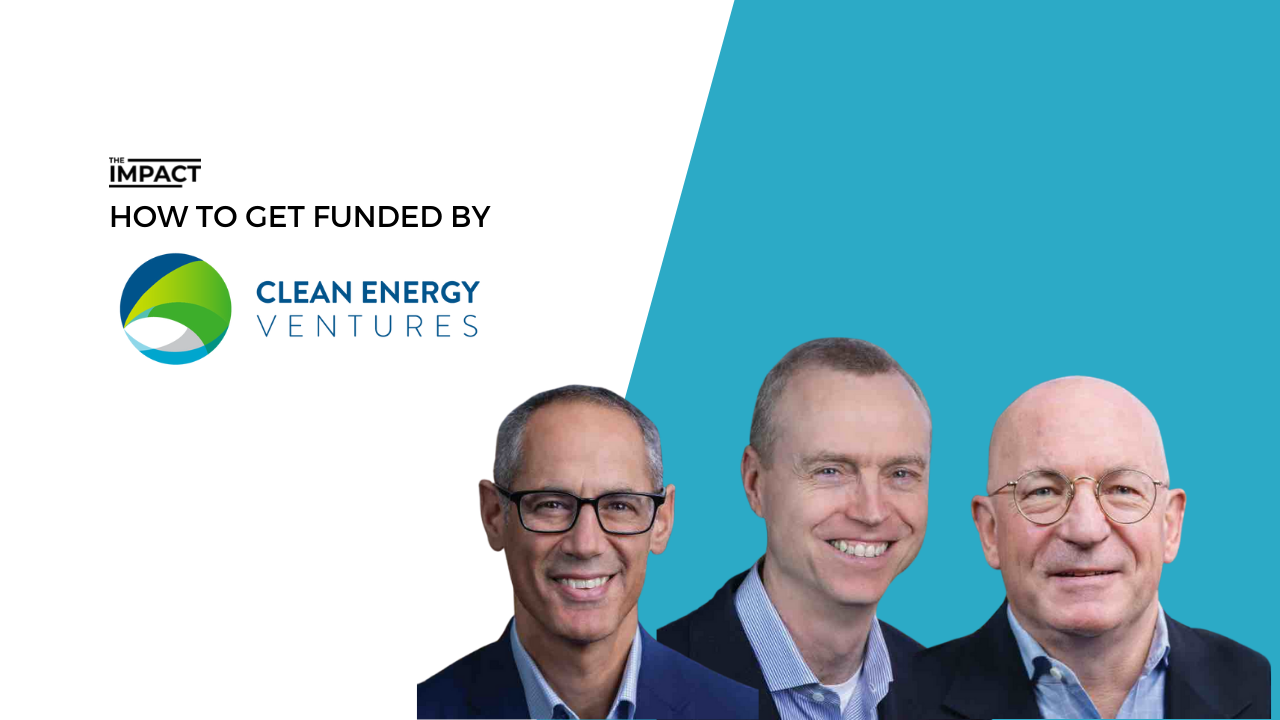Clean Energy Ventures (CEV) is investing in climate tech startups that can reduce 2.5 Gt of CO2e between now and 2050 (each). CEV is open to investing in engineering and team risk, as they provide hands-on mentorship post-investment.
Fund Snapshot
- Stage: Pre-Seed – Series A
- Check Size: $500kK – $4M
- Geography: North America, Europe and Israel starting in late 2022
- Lead/Follow: Lead
- Revenue/Valuation Thresholds: Pre- and post-revenue startups; valuations commensurate with stage of company
About the Fund
Why was the fund created?
CEV was created to make a meaningful dent in reducing the greenhouse gas emissions associated with climate change and provide a venture-grade financial return to investors. The firm’s founders have been investing together in climate tech since the early 2000s.
In 2005, Dan Goldman and Dave Miller co-founded the Clean Energy Venture Group (CEVG), CEV’s sister organization of angel investors, to create funding and support for early-stage clean energy startups and to help expand the overall clean energy ecosystem in the US. CEVG has invested in over 35 startups and generated a strong financial track record to date.
By 2017, the deal flow within the angel group far outgrew its capacity to make individual investments and help portfolio companies scale. To address this, Dave, Dan, and Temple Fennell co-founded CEV and raised a $110M venture capital fund solely focused on leading first round climate tech investments with large emissions reduction potentials.
Today, CEV and CEVG work together to source new investment opportunities, perform due diligence and provide heavy support to the portfolio companies in which they invest.
What is CEV’s core belief?
CEV believes that the serious reduction of greenhouse gasses and the profitability of businesses go hand-and-hand. They believe that you don’t have to sacrifice a businesses’ impact on climate change for financial returns, or vice versa. In fact, they believe the companies that can reduce more GHGs in the coming decades will be the companies that are intrinsically worth more.
What domains in climate tech does CEV have the greatest expertise in?
CEV has significant expertise in scaling B2B hard tech. Based on the fund’s name, CEV has expertise in clean energy, but they define it broadly: anything that can reduce 2.5 Gt of CO2e between now and 2050 through the production or use of energy. This includes the expected sub-sectors like solar panel innovations, startups focused on energy management, and energy storage. It also includes sub-sectors that might surprise you, such as recycling and re-use and advanced materials like concrete and carbon fiber.
The firm was founded by Dan Goldman, Dave Miller, and Temple Fennell. All three founders have been investing in climate tech for over a decade together, have founded their own companies, and have held senior operating positions in mature businesses.
Between CEV and their angel-investor sister organization, CEVG, there’s a team of 40+ experienced business operators, engineers, former/current entrepreneurs and investors who find deals, perform diligence and support companies after investment. This includes former FERC chairman; former senior executives at companies like Siemens, GE, and Cabot Industries; and founders of numerous successful clean energy startups and environmental non-profits.
What type of portfolio support does CEV provide?
CEV is considered one of the most hands-on and experienced post-investment mentors in climate tech by the multinational companies that co-invest with them and other VCs.
CEV has found that the companies that see the strongest returns are the companies where they provide great support after investment. The fund spends a disproportionate amount of time helping with a company’s success compared to other investors. CEV specializes in helping climate tech companies cross the chasm from early-stage (e.g., just out of the lab) through early-growth (e.g. quickly growing customer base):
- CEV has leadership coaches who provide leadership team evaluation during diligence and then often continue engagement with a startup’s leadership team after investment to help them understand and improve the human system within the business.
- The Director of Marketing plays an operating role, helping portfolio companies look and act like billion-dollar businesses before they typically would do so themselves. This helps them attract better talent, grab the attention of new investors, and build trust with customers.
- CEV’s investments team (a highly technical group) regularly engages with portfolio companies after investment to help troubleshoot major engineering challenges, expand patent protection, and understand new markets.
- CEV provides a network of connections for future investors, independent board members, advisory boards, customers, and multinational partners like major OEMs.
CEV can also leverage resources from the Clean Energy Venture Group (CEVG), their sister organization of angel investors.
About Investments
What is CEV’s investment process and timeline?
CEV has five stages of their investment process: Screening, Scouting, Pitching, Early Diligence, and Late Diligence. Since CEV performs diligence on deals together with CEVG, more than 40 investors are typically weighing in on a prospective investment at one stage or another.
All investments begin via an application on their website. They’re then screened for critical basic criteria, like focus area, stage of development, and geographic region. Then, more than 40 investors have the chance to review their application and provide written comments. The team then discusses these results as a group during Scouting and invites entrepreneurs to pitch in front of the combined CEV and CEVG group. Following a successful pitch, CEV moves into early diligence where they ask a lot of questions, review intellectual property strategies, conduct site visits, have select calls with customers, discuss with experts and business leaders for an outside perspective, and issue a term sheet. If the term sheet is accepted, CEV proceeds to Late Diligence, which focuses mostly on documentation, negotiation, and verifying data provided by the company. This last stage also includes leadership team evaluation, which is something CEV approaches rigorously with their leadership coaching team.
All-in-all, this process can take as little as four weeks, and as many as ten depending on how fast the company is at providing materials and making connections, and the competitive situation.
What would make CEV consider deviating from its typical criteria?
Most of the team has been investing in climate tech since the term ‘cleantech’ was coined in the early 200s. Also, the biggest challenge today is understanding and deciding how to deal with all the froth happening in climate tech venture capital. As a result, the team is resistant to ‘hype cycles’ and sticks closely to their investment criteria, while understanding that climate tech is also reaching into new markets and new frontiers regularly.
About The Author

Daniel currently works at Lawrence Livermore National Laboratory as a Product Manager. Outside of his day job, he is a Principal at C3, Tech Scout at For ClimateTech, and Venture Scout at Prithvi. He also works with various climate incubators/accelerators (Cleantech Open, Techstars, and Joules Accelerator) and runs The Impact and Innovate Climate – both are newsletters covering startups in the climate space.

